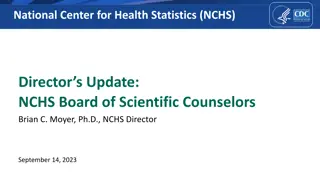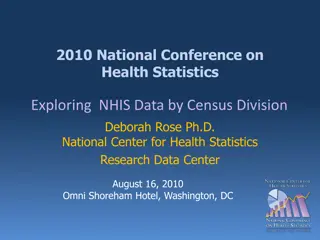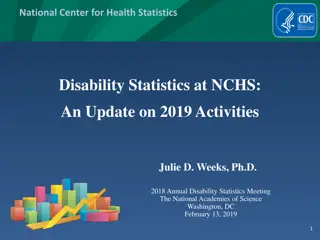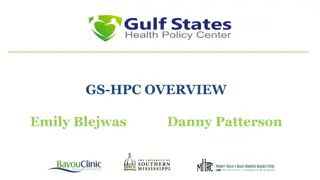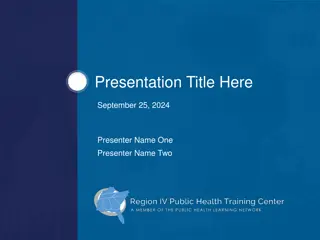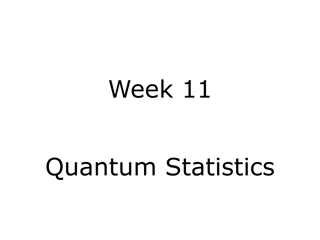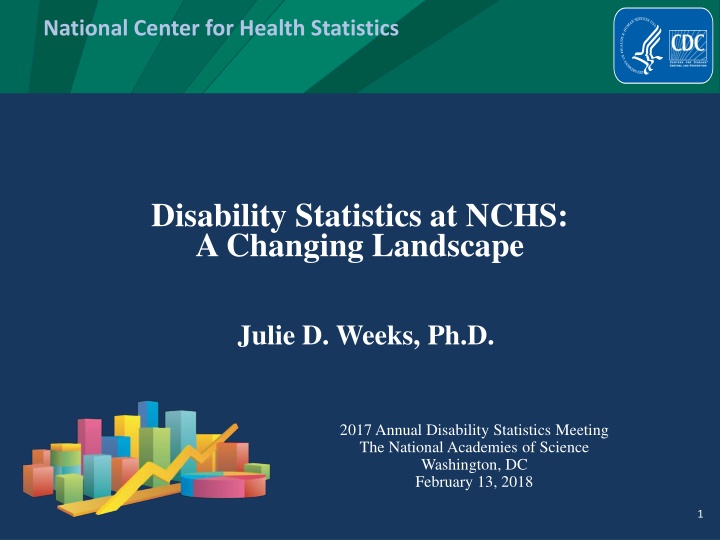
NHIS Disability Measurement Developments and Redesign Analysis
Explore the changing landscape of disability statistics through recent developments in the National Health Interview Survey (NHIS). From content redesign to respondent burden reduction, discover the implications for data quality and long-term planning.
Download Presentation

Please find below an Image/Link to download the presentation.
The content on the website is provided AS IS for your information and personal use only. It may not be sold, licensed, or shared on other websites without obtaining consent from the author. If you encounter any issues during the download, it is possible that the publisher has removed the file from their server.
You are allowed to download the files provided on this website for personal or commercial use, subject to the condition that they are used lawfully. All files are the property of their respective owners.
The content on the website is provided AS IS for your information and personal use only. It may not be sold, licensed, or shared on other websites without obtaining consent from the author.
E N D
Presentation Transcript
National Center for Health Statistics Disability Statistics at NCHS: A Changing Landscape Julie D. Weeks, Ph.D. 2017 Annual Disability Statistics Meeting The National Academies of Science Washington, DC February 13, 2018 1
A number of disability measurement developments National Health Interview Survey (NHIS) Content redesign for 2019 Extensive changes to disability content Changes to structure and periodicity of measures Washington Group measures for adults and children Disability statistics: implications to consider
NHIS Redesign Why redesign? Most recent major content redesign occurred in 1997 Respondent burden increasing and response rates decreasing Why now? Reduce respondent burden and improve data quality Necessary sampling frame redesign in 2016 introduced additional complexity Final measurements for Healthy People 2020 objectives can be completed in 2016 and 2017 Long-term planning can help sponsors target content
Length of Completed Interviews, by Quarter: NHIS, 2006-2015 110 100 90 80 Time in Minutes 70 60 50 40 30 20 Mean Median 10 0 Year and Quarter
NHIS Family, Child, and Adult Response Rates, NHIS 1997-2015 95 90 85 80 Percentage Family module 75 70 Sample Child module 65 60 Sample Adult module 55 50 2003 2014 1997 1998 1999 2000 2001 2002 2004 2005 2006 2007 2008 2009 2010 2011 2012 2013 2015 Year
Criteria for Prioritizing Content Strong link to public health: Leading causes of morbidity/mortality, known risk or protective factors, priority populations at risk, intermediate outcomes Relevant to HHS agency goals: Part of HHS strategic plan, HHS initiatives Needed for long-term monitoring: Leading health indicators High quality measurement: Content can be measured well in household interviews Consistent with other federal surveys: Measure is used by others for calibration, does not duplicate detail collected by targeted HHS surveys Can be estimated reliably with one or two years of data: Less focus on rare conditions or behaviors
NHIS Disability Content Before redesign: ADLs IADLs Basic Actions Difficulties Complex Activity Limitations Personal Care ACS Set WG Short Set WG Extended Set Work Limitation Social Activity Limitation Participation Limitation Age of onset
NHIS Disability Variable Count Functioning variables on the core section NHIS approximately 170 functioning variables: - 36 asked on the Family section - 100 asked of the Sample Child - 33 asked of the Sample Adult ACS variables: - 6 asked on the Family section - 6 asked of the Sample Child - 6 asked of the Sample Adult WG variables - 63 asked of Sample Adult This is a total of roughly 250 disability variables to program, administer, clean, weight, etc.
Redesign NHIS Disability Content Before redesign: ADLs IADLs Basic Actions Difficulties Complex Activity Limitations Personal Care ACS Set WG Short Set WG Extended Set Work Limitation Social Activity Limitation Participation (IADL) Limitation Condition Causing (problem) Age of onset After redesign: WG Short Set WG Extended Set Work Limitation Social Activity Limitation Participation (IADL) Limitation WG-UNICEF Child Module
WG Short Set on Functioning 1-5. How much difficulty do you have: seeing even if wearing glasses? hearing even if using a hearing aid? remembering or concentrating? walking or climbing stairs? with self-care, such as washing all over or dressing? 6. Because of a physical, mental or health condition, how much difficulty do you have communicating, for example understanding or being understood by others? Response: a) No, no difficulty b) Yes some difficulty c) Yes a lot of difficulty d) Cannot do at all
WG Extended Set on Functioning Additional questions in these domains: Hearing Cognition Mobility Additional functional domains: Communication Upper body Affect (anxiety and depression) Pain Fatigue Four-category response options
WG-UNICEF Child Functioning Module A survey module specifically designed to capture functioning for children 2-4 and 5-17 years. Emotions (Anxiety and Depression)+ + Controlling Behaviour Focusing Attention / Concentrating+ + Coping with Change+ + Relationships+ + Playing* Seeing Hearing Mobility Self-care+ + Fine Motor* Communication Learning (and Remembering+ +) * Domains specific to those 2-4 years of age + + Domains specific to those 5-17 years of age
WG-UNICEF Module on Inclusive Education Purpose To address the association between environmental barriers and school participation. Proposed content Attitudes: societal and cultural norms; perceptions and attitudes of parents, other students and school staff School Environment: physical and academic accessibility Affordability: fees, costs, and competition for resources associated with attendance Out of school: reasons why a child may be out of school
2018 2019 2020 2021 2022 2023 2024 2025 2026 Household Roster - Selection of Sample Adult - Informed Consent The Quilt Health Status - Hypertension - High Cholesterol - Cardiovascular Conditions Asthma - Cancer - Diabetes - Other Chronic Conditions - Height and Weight Difficulties with Vision, Hearing, Mobility, Communication, Cognition, and Self-Care Anxiety - Depression - Social Functioning Annual core content Health Insurance Status and Continuity Financial Burden of Medical Care - Health Care Utilization and Access Annual core Key measures Sociodemographics Prescription Medication - Immunizations Cigarettes and E-cigarettes Marital Status - Veteran Status - Nativity Housing - Schooling - Employment Rotating core Newer topic areas Expanded detail Varying periodicity Family Income - Food-Related Program Participation Telephone Use - Linkage Information Dental, Mental, Other Care Utilization Rotating Conditions Dental, Mental, Other Care Utilization Rotating Conditions Dental, Mental, Other Care Utilization Rotating Conditions Rotating core Mental Health Assessment Employment Detail - Injuries Mental Health Assessment Employment Detail - Injuries Mental Health Assessment Employment Detail - Injuries Sponsored supplements Sustaining sponsors 1- or 2-year modules 5 min or less Chronic Pain - Preventive Services Chronic Pain - Preventive Services Chronic Pain - Preventive Services Chronic Pain - Preventive Services Chronic Pain - Preventive Services Health Behaviors Health Behaviors Health Behaviors Health Behaviors Sustaining Sponsors Content from sponsors that commit to supplements every year Sponsored content 1-year supplements 1-year supplements 1-year supplements 2-year supplements 2-year supplements 2-year supplements 1-year supplements 1-year supplements 1-year supplements 2-year supplements 2-year supplements 2-year supplements 1-year supplements 1-year supplements 1-year supplements 1-year supplements 1-year supplements 1-year supplements 1-year supplements 1-year supplements 1-year supplements
2019 NHIS: Proposed Core Modules Sample Adult Core Self-response (unless unable) Relevant family-level data Fielded with fixed periodicity Demographics, some family relationships, and family income; Health insurance, utilization, conditions, and behaviors Sample Child Core Knowledgeable adult responds for child Relevant family-level data Fielded with fixed periodicity
Rotating Content How to balance the collection of relevant health content and crucial covariates with respondent burden and funding constraints? Some questions will appear with fixed periodicity, not annually Pros: Less time intensive than asking all questions every year Can still monitor changes in trends with periodic data Cons: Data will not be available annually for all topics
2019 NHIS: Impact of Module Approach Shifting content from collection in family module to collection in sample adult and/or sample child modules Changes in: Salience: Gets to the health questions quickly Basicdemographics: Collected on all household members Demographic detail: Collected for sample adult and sample child Person-level sample size: Limits utility of rare event questions Respondent for adult health status and disability: From proxy to self Respondent for demographics and insurance: From family respondent to sample adult
Periodicity of Functioning Content on NHIS Annual Core - Adults: WG Short Set WG Extended Set (almost*) Social Activity Limitation Participation (ACS IADL) limitation Work Limitation` Annual Core - Children: WG-UNICEF Child Module (vision, hearing, mobility, motor skills and self-care, communication, cognition, affect, behavior) Social/emotional screening for very young children 3-year Rotation - Adults: Mental Health Assessment K-6 and GAD/PHQ-9 (but not at same time) Hearing Detail* SDQ, SDQ-Impact 2-year Rotation - Adults (non-overlapping): Pain* Fatigue*
WG Question Sets Milestones Short Set on Functioning (6 questions): Adopted in 2006 Added to 2009 NHIS Adopted as the international standard for disability measurement for the 2020 Round of Censuses by UN and UNECE Implemented in surveys and censuses internationally, including DHS Used to monitor the CRPD and the SDGs Extended Set on Functioning (additional functional domains): Adopted in 2010 Added to 2010 NHIS Module on Child Functioning and Disability Developed in collaboration with UNICEF Adopted in 2016 Added to 2019 NHIS Module on Inclusive Education Under consideration for addition to NHIS
Disability Statistics from the NHIS Inform Departmental and Federal disability-related activities. Health, U.S.: Historically, used limitation of activity due to a chronic condition In 2009, moved to Basic Actions Difficulties and Complex Activity Limitation In 2017, will use the WG Short Set on Functioning (WG-SS) Healthy People Include in the core of all applicable Healthy People population data systems a standardizedset of questions that identify people with disabilities. HP2020: Adopted ACS as the standard measure of disability HP2030: WG-SS used as the standard measure of disability from NHIS OMB Reporting WG-SS used for Social Indicators, Analytical Perspectives: Budget of the U.S. Government (http://www.whitehouse.gov/omb/budget/Analytical_Perspectives/ )
Disability Statistics from the NHIS Other NCHS data collections NHANES NSFG Forthcoming Publications to Inform Change Transition from ACS to WG Comparison of ADLs and WG Identification of special populations (e.g., DD, program eligibility/receipt)
ACS Questions Is this person deaf or does he/she have serious difficulty hearing? Is this person blind or does he/she have serious difficulty seeing even when wearing glasses? Because of a physical, mental, or emotional condition, does this person have serious difficulty concentrating, remembering, or making decisions? Does this person have serious difficulty walking or climbing stairs? Does this person have difficulty dressing or bathing? Because of a physical, mental, or emotional condition, does this person have difficulty doing errands alone such as visiting a doctor's office or shopping? Response: Yes / No
Comparison of ACS vs. WG-SS Functioning Domain ACS WG-SS Question Text Question Text Do you have difficulty seeing, even when wearing glasses? Hearing Are you deaf or do you have serious difficulty hearing? Are you blind or do you have serious difficulty seeing even when wearing glasses? Do you have difficulty hearing, even when using a hearing aid? Vision Because of a physical, mental, or emotional condition, do you have serious difficulty concentrating, remembering, or making decisions? Cognition Do you have difficulty remembering or concentrating? Mobility Do you have serious difficulty walking or climbing stairs? Do you have difficulty walking or climbing stairs? Do you have difficulty (with self-care such as) washing all over or dressing? Self-Care Do you have difficulty dressing or bathing? Independence (IADLs) Because of a physical, mental, or emotional condition, do you have difficulty doing errands alone such as visiting a doctor's office or shopping? n/a Using your usual (customary) language, do you have difficulty communicating, for example understanding or being understood? Communication n/a


